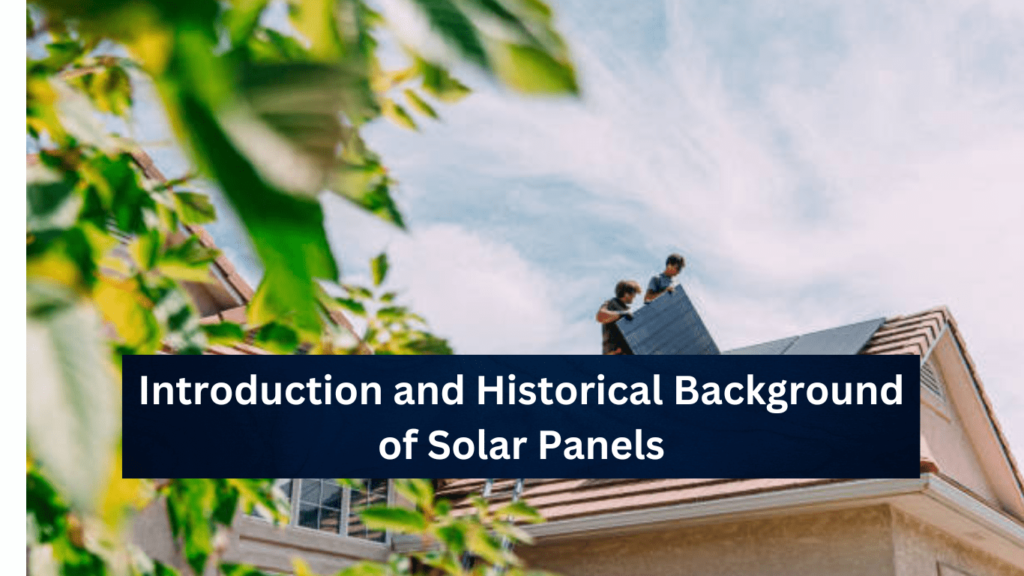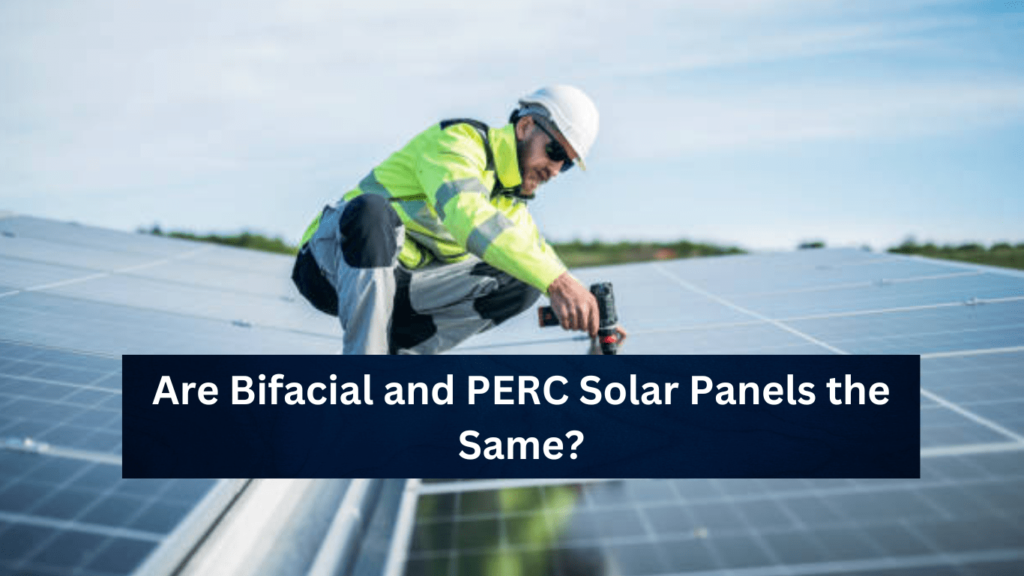Pakistan has seen a significant increase in the adoption of solar energy, particularly since 2020, driven by frequent power outages, rising energy costs, and the decreasing prices of solar technology. As the nation embraces solar power more widely, individuals and businesses need to understand the various types of solar panels available. This knowledge can help optimize energy efficiency, reduce expenses, and make informed decisions aligned with specific needs.
This comprehensive guide will explore the different types of solar panels in Pakistan, ranging from traditional monocrystalline and polycrystalline panels to newer thin-film and bifacial technologies. We'll delve into their distinctive features, benefits, and potential limitations. But first, let's review some basic information about solar panels.
Table of Contents (Solar Panels In Pakistan)

Introduction and Historical Background of Solar Panels:
Solar panels utilize the photovoltaic effect to convert sunlight into electricity. The concept dates back to the nineteenth century when French physicist Alexandre Edmond Becquerel discovered the photovoltaic phenomenon in 1839. However, practical solar cells were developed in the mid-twentieth century.
In 1954, Bell Laboratories introduced the first silicon-based solar cell with an efficiency of approximately 6%. Since then, advancements in solar panel technology have led to increased efficiency and decreased costs. Solar panels are now widely recognized as a worldwide clean and sustainable energy option.
How Solar Panels Work?
Solar panels consist of interconnected solar cells encased in a protective coating. Silicon, a semiconductor material, is commonly used in these cells' production. When sunlight hits the solar cells, it excites electrons within the silicon atoms, generating an electric current.
The solar cells are typically sandwiched between two glass or transparent plastic layers. The top layer allows sunlight to penetrate while shielding the cells from external elements. The bottom layer collects and channels the electricity generated by the solar panel. This electricity is produced in direct current (DC), then converted into alternating current (AC) by an inverter for use in most homes and businesses.
Top 5 Best Types of Solar Panels in Pakistan

Monocrystalline Solar Panels: High Efficiency and Longevity
Monocrystalline solar panels, also known as single-crystalline solar panels, are a prevalent choice in Pakistan's solar industry due to their remarkable energy efficiency. This section explores their unique features, benefits, and considerations.
Impressive Energy Efficiency
Monocrystalline panels are renowned for their exceptional energy efficiency, making them a favored option in Pakistan's solar installations. This efficiency, often ranging from 20-22%, results from their manufacturing process, which utilizes a single crystal structure of high-purity silicon.
Optimal Power Generation
With their high-efficiency rates, monocrystalline panels can convert a significant portion of sunlight into usable electricity. This capability allows them to generate more power from the same amount of sunlight as other panel types, making them ideal for areas with limited space or regions prone to shading or cloudy conditions.
Uniform Crystal Structure
The outstanding efficiency of monocrystalline panels can be attributed to their uniform crystal structure. This single crystal structure facilitates more efficient movement of electrons, thereby reducing energy losses within the panel. Additionally, high-purity silicon further enhances their ability to convert sunlight into electricity effectively.
Considerations: Cost and Lifespan
While monocrystalline panels offer exceptional performance, they are more expensive than other solar panel options. However, their increased efficiency and long-term reliability often justify this higher upfront cost. Monocrystalline panels are known for their robust construction, ensuring reliable performance over 25+ years.
Polycrystalline Solar Panels: Efficiency and Durability
Polycrystalline solar panels, also known as multi-crystalline panels, are widely used in solar installations in Pakistan. This section explores their characteristics, efficiency, durability, and differences from monocrystalline panels.
Distinctive Manufacturing Process
Polycrystalline panels derive their name from their manufacturing method, which uses silicon material with multiple crystals instead of a single crystal structure. This results in a unique appearance characterized by a mottled blue color, distinguishing them from monocrystalline panels.
Efficiency and Technological Advancements
Although polycrystalline panels generally have slightly lower efficiency than monocrystalline panels, technological advancements have significantly narrowed this gap. Polycrystalline panels typically offer conversion efficiencies ranging from 15% to 18%, which is still commendable and capable of generating substantial solar energy. Ongoing improvements in production techniques and the use of high-quality silicon materials enhance the efficiency of polycrystalline panels over time.
Durability and Longevity
Polycrystalline solar panels are recognized for their durability and reliability. They can have a lifespan of 25 years or more with proper installation and maintenance. However, factors such as climate conditions and maintenance practices can influence their exact lifespan.
Visual Distinctions and Price Point
Polycrystalline panels can be distinguished visually by their mosaic-like pattern and blue hue, resulting from the multiple crystal structures. In contrast, monocrystalline panels have a uniform black or dark blue color with a square dot at the corners of their cells.
Moreover, polycrystalline panels are generally more cost-effective than monocrystalline panels, making them an attractive option for those seeking a balance between efficiency and affordability in their solar energy systems.
Polycrystalline solar panels offer commendable efficiency, durability, and affordability, making them a practical choice for solar installations in Pakistan.
Thin-Film Solar Panels: Flexibility and Performance
Thin-film solar panels represent an innovative and distinct type of solar technology with unique advantages in specific applications. This section explores their characteristics, efficiency, lifespan, and suitability for various installations.
Flexible and Lightweight Design
Thin-film panels are manufactured by depositing a thin layer of photovoltaic material onto a substrate, such as glass or metal. This manufacturing process enables flexibility, a lightweight design, and potential cost savings compared to traditional crystalline silicon panels.
Appearance and Color Variations
Thin-film panels are uniform and smooth, lacking the visible individual cells found in crystalline silicon panels. Their color may vary depending on the material used, ranging from dark brown to bluish-black.
Efficiency and Performance
While thin-film solar panels generally have lower efficiency than crystalline silicon panels, typically ranging from 10% to 12%, they offer advantages in other areas. These include lower costs, improved performance in low-light conditions, and a broader spectral response, enabling them to generate electricity even under cloudy or shaded conditions. Their ability to cover larger areas also offsets the lower efficiency, making them suitable for large-scale installations where space is not a constraint.
Lifespan and Maintenance
Thin-film solar panels have shorter lifespans than crystalline silicon panels, typically lasting 10-20 years. Additionally, their performance degradation rate may be slightly higher over time. Regular maintenance and proper installation practices are essential to mitigate degradation and ensure optimal performance throughout their lifespan.
Suitability for Installations
While thin-film solar panels offer advantages, they may not be suitable for residential homes in Pakistan due to their lower efficiency compared to crystalline silicon panels. In a country with abundant sunlight like Pakistan, maximizing energy generation from limited rooftop space is more beneficial. However, thin-film panels find practical applications in large-scale commercial installations or projects without constrained space, such as solar farms or industrial installations.
Enhancing Solar Efficiency with PERC Technology
Passivated Emitter and Rear Cell (PERC) solar panels utilize innovative technology to enhance the efficiency of traditional solar panels. This section explores how PERC technology works, its benefits, and its compatibility with different types of solar panels.
Understanding PERC Technology
PERC, which stands for Passivated Emitter and Rear Cell, is not a distinct type of solar panel but rather a technology that can be integrated into various solar panel designs to improve performance.
Maximizing Solar Cell Efficiency
PERC technology involves adding a specialized layer to the back of solar cells to minimize energy loss by reducing electron recombination. This process seals potential energy leakage points, allowing solar cells to capture and utilize more sunlight efficiently, thereby increasing electricity production.
Compatibility and Adaptability
One notable advantage of PERC technology is its versatility, as it can be incorporated into monocrystalline and polycrystalline solar panels. This flexibility enables solar panel manufacturers to enhance their existing designs with PERC technology, providing consumers with a wider range of options when selecting solar panels for their homes.
Market Availability and Considerations
Many solar panels available in the Pakistani market utilize PERC technology to improve their efficiency and performance. Consumers should ask their solar installer whether the panels installed on their rooftops are equipped with PERC technology.
Maximizing Solar Efficiency with Bifacial Technology
Bifacial solar panels represent an intriguing innovation to enhance the effectiveness of solar energy generation. This section explores how bifacial technology works, its advantages, and its potential applications in various environments.
Understanding Bifacial Technology
Bifacial solar panels are not a distinct type of solar panel like monocrystalline or polycrystalline panels. Instead, bifacial technology is a special feature that can be integrated into different types of solar panels, such as monocrystalline and polycrystalline, to optimize their performance.
Harnessing Sunlight from Both Sides
As the name suggests, bifacial panels can capture sunlight from both the front and back sides. While traditional solar panels only absorb sunlight from their front side, bifacial panels have a transparent back sheet or glass back, enabling them to absorb sunlight from both directions, including reflected light.
Increasing Energy Output
Bifacial solar panels can generate more electricity than conventional panels by capturing sunlight from both sides. When sunlight hits the front side of the panel, it produces electricity as usual. However, the panel's backside also plays a crucial role by capturing reflected light, such as sunlight bouncing off surfaces like the ground or nearby buildings, and converting it into additional electricity. This dual-sided approach allows bifacial panels to maximize energy output and make the most of available sunlight.
Benefits and Potential Applications
Utilizing both sides of the panel through bifacial technology significantly increases the potential for electricity generation. This feature is particularly advantageous in areas with high albedo, such as snowy landscapes or regions with bright surroundings. Additionally, it opens up opportunities for innovative installation methods, such as mounting panels on canopies or over water bodies, where panels can capture sunlight from above and reflected light from below.
Bifacial solar panels equipped with bifacial technology offer enhanced energy generation capabilities by harnessing sunlight from both sides. This innovative approach increases energy output and presents new possibilities for creative installation methods in various environments.
Are Bifacial and PERC Solar Panels the Same?
Despite representing advancements in solar panel technology, Passivated Emitter and Rear Cell (PERC) and bifacial solar panels are distinct entities.

PERC panels, categorized as monocrystalline solar panels, integrate a passivated emitter and a rear cell structure. The passivation process entails applying a thin layer of insulating material to the front surface of the solar cell, thereby minimizing recombination losses and enhancing overall efficiency. The rear cell design facilitates improved light absorption and reflection within the panel, further optimizing its performance.
In contrast, bifacial solar panels are a different type capable of generating electricity from both module sides. Unlike conventional solar panels that solely utilize the front side to convert sunlight into electricity, bifacial panels feature transparent back sheets or glass on the rear side, enabling them to capture light reflecting off the ground or other surfaces. This additional exposure to light can lead to increased energy production.
While PERC and bifacial panels are separate technologies, solar panels can combine both features and be classified as PERC bifacial panels. These panels would incorporate the passivated emitter and rear cell structure while allowing energy generation from both sides of the module.
Conclusion:
Understanding the differences between various solar panel types is essential when choosing the most suitable option. Monocrystalline solar panels are highly recommended for optimal performance, but polycrystalline panels can also be effective, particularly in cases where space constraints exist. Please contact us for personalized guidance on selecting the ideal solar panel type based on individual goals and needs. We are here to assist you in making informed decisions.
